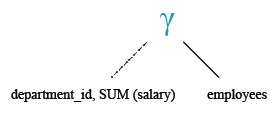PostgreSQL Aggregate Functions and Group By: Get the department ID and the total salary payable in each department
10. Write a query to get the department ID and the total salary payable in each department.
Sample Solution:
Code:
-- This SQL query retrieves the total salary for each department.
SELECT department_id, SUM(salary) -- Selects the department_id and calculates the sum of salaries for each department
FROM employees -- Specifies the table from which to retrieve data, in this case, the employees table
GROUP BY department_id; -- Groups the results by department_id, so that the sum of salaries is calculated for each unique department_id
Explanation:
- The SQL query calculates the total salary for each department.
- The SELECT statement selects both the department_id and the sum of salary for each department.
- The FROM clause specifies the table from which to retrieve the data, which is the employees table.
- The GROUP BY clause groups the results by department_id, ensuring that the sum of salaries is calculated for each unique department.
- For each department, the SUM() function calculates the total salary by adding up all the salaries of employees within that department.
- The result set will contain one row for each unique department_id, along with the total salary for each department.
Sample table: employees
Output:
pg_exercises=# SELECT department_id, SUM(salary)
pg_exercises-# FROM employees
pg_exercises-# GROUP BY department_id;
department_id | sum
---------------+-----------
90 | 58090.00
20 | 19060.00
100 | 51780.00
40 | 6530.00
110 | 20360.00
80 | 295990.00
70 | 10030.00
50 | 157750.00
60 | 28950.00
30 | 25080.00
10 | 4430.00
0 | 7030.00
(12 rows)
Relational Algebra Expression:

Relational Algebra Tree:

Go to:
PREV : Write a query to find the manager ID and the salary of the lowest-paid employee under that manager.
NEXT : Write a query to get the average salary for each post excluding programmer.
Practice Online
Have another way to solve this solution? Contribute your code (and comments) through Disqus.
What is the difficulty level of this exercise?
